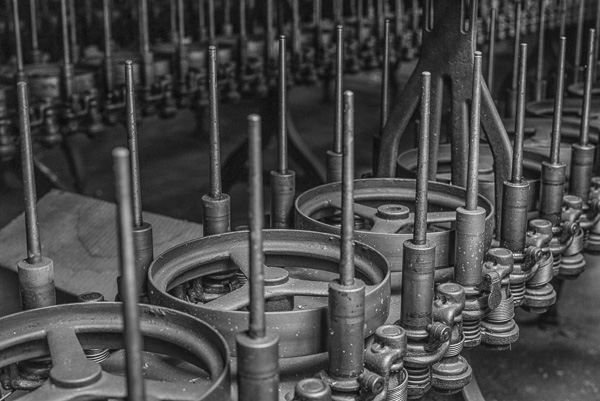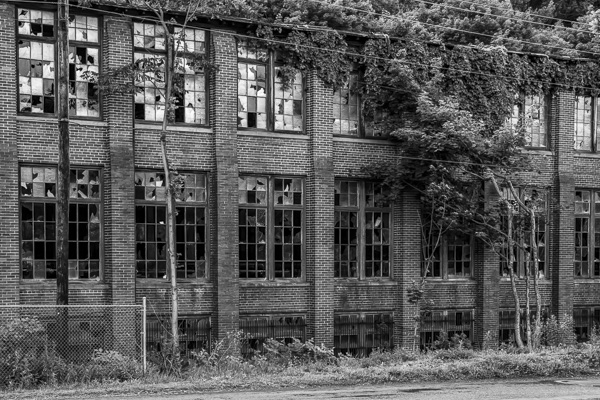With her first paycheck from the Lonaconing Silk Mill - $74 for two weeks of work - Betty Lou McIndoe bought herself a "gold wind-up wrist watch with a black face." Betty Lou began working at the mill, in western Maryland, in 1948, when she was 18. Her mother started work in the mill, in 1924, at age 13. Betty Lou's stepfather, Charlie Walters, was the mill superintendent; her aunt, uncle, boyfriend, and several high school friends also worked at the mill. "It was like a big happy family - well, all my family worked here," she said recently. She still has the watch she bought with her first paycheck.
October 1948: Betty Lou Robertson, 18 years old, is 2nd row, third from left, and William McIndoe (her future husband) is 1st row, far left.
The Klotz Throwing Company, based in New York City, began construction of the Lonaconing mill in August 1905, and opened for business in April 1907. Klotz already had a successful plant in South Cumberland, not far from Lonaconing, and liked to locate its mills in coal-mining areas, which had railroads, lots of cheap labor, and fewer laws and regulations than the big city. As many as 80 percent of the mill workers were women.
The mill took raw silk and turned it into yarn or thread that could be used in the manufacture of clothing and other items. The mill had its own railroad siding, where bales of silk from Japan and China were delivered. Each bale had a "chop mark" - a label from the company of origin - and each bale contained several skeins of raw silk. The silk was unpacked, unraveled, washed, dyed and dried, unwound on winding machines, spun, and "doubled" - several strands twisted and wound together to make a thicker, stronger yarn. It was then wound on bobbins, quills, and cones to be shipped to customers.
Chopmarks (historic)
Business was so good that an addition to the mill was built in 1916. In 1920 records show that 359 people worked at the mill, which contributed greatly to the prosperity of Lonaconing, which at one point had two newspapers, an opera house, hotels, banks, a theatre, and a number of stores. The mill provided stable employment, which was important when the men who worked the coal mines were furloughed during slow periods, or were not working due to a labor disruption.
The mill survived the Great Depression, halting operations only briefly, though Klotz declared bankruptcy in 1932 and reorganized as General Textile Mills. The number of employees fell dramatically. The embargo of Japanese products during WWII hurt the silk business, though the mill used the remaining silk and also produced rayon, primarily for the use of army products such as parachutes. Business picked up during the war, but by the late 1940's employment and production were declining. The decline of silk in favor of the new synthetic yarns affected mill business, and the old machines made it hard to compete with newer, more efficient mills.
Betty Lou McIndoe, 2017 (from video)
Betty Lou's superintendent stepfather wouldn't let her work on the machines, so she worked in the basement on "the tables." The men would unload skeins of silk from the bales, and bring them to the women working at the tables. The women would unravel the skeins and then tie them in such a way that they could be thrown in a tub and washed. Betty Lou worked at a table which included her aunt and at least one high-school friend. She left the mill in 1953, after her stepfather died, and went to work selling jewelry at a department store in Cumberland.
Ronnie Shaw, 2017 (from video)
Ronnie Shaw worked at the mill in 1956 or 1957. He was 19 years old, and a friend helped him find the job. He remembers only 15 to 20 people working in the entire mill, and that, at best, only half the machines in the building were active at any time. Ronnie was responsible for maintaining the machines - cleaning the spindles, filling them with oil, and then aligning and leveling them. He'd work down a row of machinery on one side, while someone else would work the other side. Together they'd maintain two or three rows of machines in a day.
When the machines were running - spinning and moving - they had "a singing noise to them." After about two months on the job, Ronnie was furloughed due to a slowdown in business. He found another job and never went back to the mill.
The mill closed suddenly in July of 1957, when workers - seeking parity with the nearby Celanese textile plant - demanded a pay raise and voted to strike. General Textile shut down the mill and operations ceased. Only a few workers remained, for several years afterwards, to perform basic maintenance.
There have been many proposals to re-use the mill, now closed for 60 years. But the same factor that has helped preserve the mill - its remoteness - is also the factor that works against its redevelopment and reuse.
Salvage companies want to buy the hand-hewn beams and maple floors. Antique dealers want to buy the wooden spindles. The country of China was going to buy the equipment for 2.5 million dollars, though the deal fell through. The current owner, Herb Crawford, wants to turn it into a museum. Other suggested uses: a school, artist lofts, and offices.
The latest proposal is to put a commercial laundry in the basement, employing 250 people, and turn the rest into a museum. The Maryland Governor's office has expressed an interest - 250 jobs is a lot of jobs for the small towns in this part of western Maryland. The proposal seems to be languishing in the state bureaucracy.
Because the mill shut down so suddenly, and because the workers were not allowed back in to retrieve their belongings, it has taken on a second life as a "time machine" of sorts - an unintentional museum of industry from the middle of the last century. Photographers and other artists come from all over the country to visit the mill and practice their art. The income they generate has helped pay for insurance and some basic maintenance.
Unfortunately, it's not nearly enough. There are now large holes in the roof, and most of the windows have been smashed and broken. The floors are buckling from the water that gets in, and parts of the mill are no longer safe to walk through. If action is not taken soon, the Lonaconing Silk Mill - the last of its kind in the country - will have to close its doors to anyone and everyone, sell off its parts to the salvagers - and be no more.
Herb Crawford and Betty Lou McIndoe, 2017.











